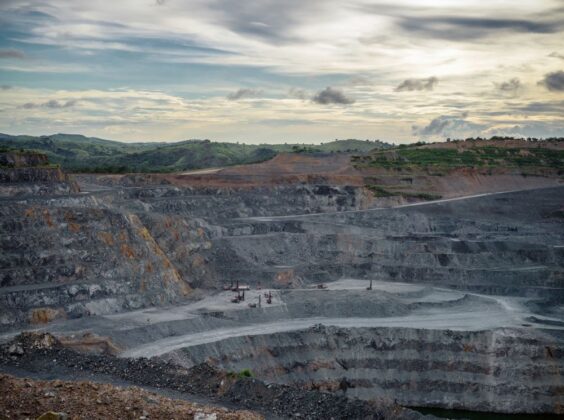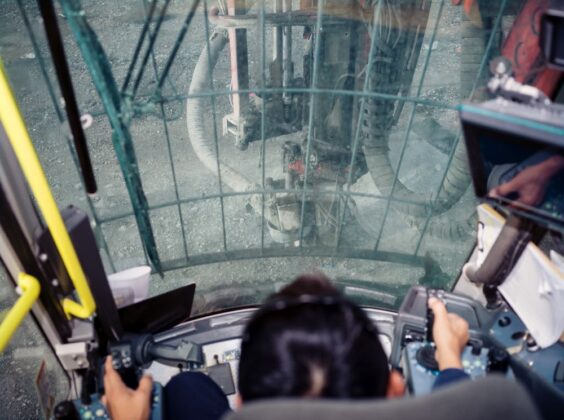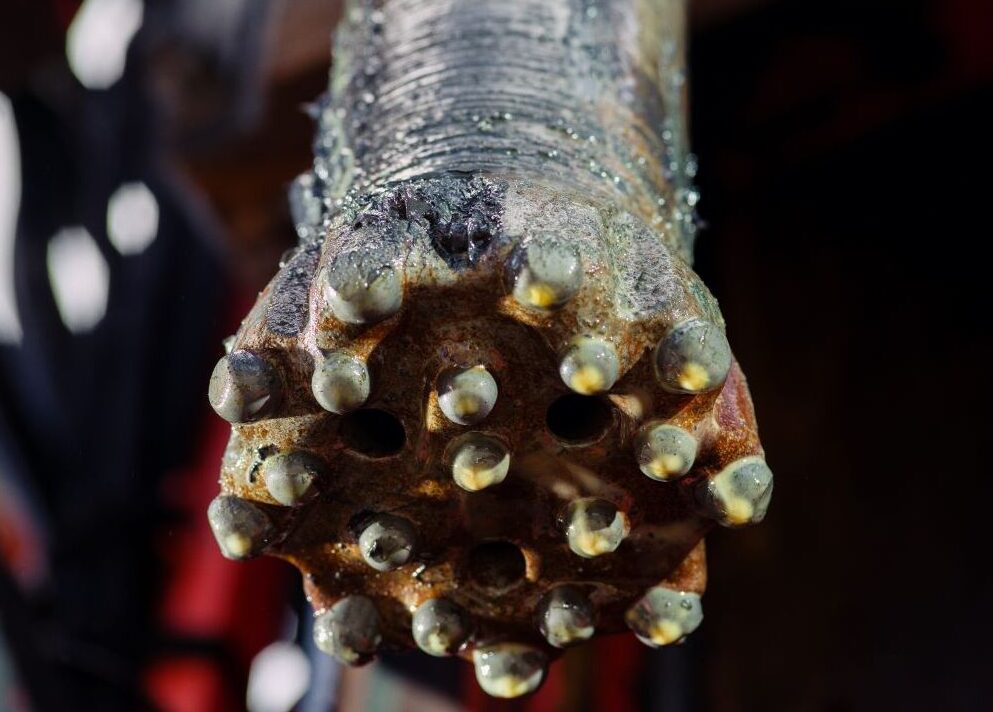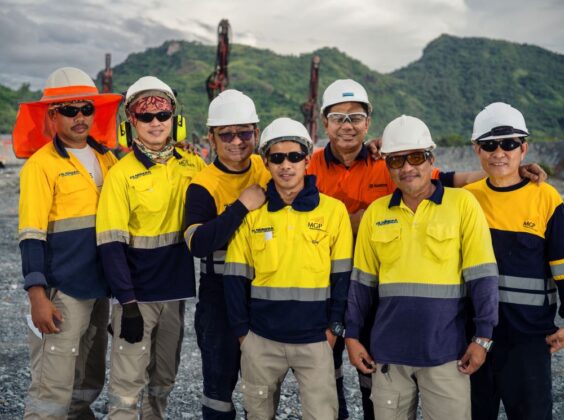The year 2025 stands out in the Sandvik Mining and Masbate Gold Project (MGP) relationship as the first year since 2019 that the original equipment manufacturer (OEM) will not deliver a Pantera™ DP1500i surface crawler rig to the mine site in the Philippines.
Back in 2012, the company delivered four top hammer rigs and, in the ensuing years, Sandvik drills have retained an exclusive position in the MGP drilling fleet with 16 Pantera DP1500is in total delivered between 2012 and 2024.
MGP, located on the island of Masbate, about 350 km south of the Philippines capital, Manila, is a conventional open-pit mine that moves some 13.4 million bank cubic metres of broken material a year. The main haulage fleet consists of Komatsu PC2000 and PC1250 excavators, and 100-tonne Caterpillar 777 haul trucks, with ore mined from two pits (the Main Vein and Blue Quartz pits as of September 2025).
MGP uses a conventional carbon-in-pulp (CIP) type facility. This facility consists of primary and secondary crushing, two-stage SAG/ball mill grinding with pebble crushing, leaching, adsorption, elution, electrowinning and smelting gold recovery stages. It also has a cyanide detoxification stage treating process plant tails in two stages before disposal in a tailings storage facility.
Behind MGP are Filminera Resources Corporation (FRC) and Phil Gold Processing & Refining Corp. (PGPRC). FRC owns the mining tenements and performs all mining activities. PGPRC owns and operates the processing plant. PGPRC and FRC have a contractual relationship in which PGPRC purchases all ores mined by FRC with both companies responsible for environment, safety and social development.
IM, along with members of the Sandvik Mining team, recently visited the mine site to see the six Pantera DP1500is drill rigs currently in use. These drills and the patterns they establish ahead of explosive loading and blasting are integral to the operation reaching its 8 Mt/y production capacity.
The gold production guidance for 2025 at MGP at the start of the year was 170,000-190,000 oz of gold at an all-in sustaining cost of $1,245-1,305/oz. Due to the excellent performance of the processing plant, this guidance has recently been upgraded to 190,000-210,000 oz.

Always available
When speaking to both the operations and maintenance teams at FRC, it became clear that the DP1500is have more than a few fans on the island of Masbate.
Sandvik refers to the Pantera DP1500i as an “intelligent, hydraulic, diesel-powered, self-propelled top hammer drill rig”. It is designed for large hole drilling, suited to production drilling in large quarries or open-pit mines, construction work sites, and wall control and development works.
The drills at MPG were under a full-maintenance contract with Sandvik from 2012 to 2017. Since MGP brought this contract in house, the OEM has managed to attain and maintain all mechanical availability targets, it says, with Ronnie G Arevalo, Mobile Equipment Maintenance Manager at FRC, saying drill rig availability had remained around 88% over this entire period.
Several nouns were consistently used in conversations about both the drills and the Sandvik personnel supporting the rigs – reliability, accuracy, accessibility and serviceability.
From a maintenance perspective at a remote mine like Masbate, the first, third and fourth nouns are crucial, enabling the operation to plan with Sandvik support staff about when spares and consumables will be needed and time the deliveries with strategic service intervals.
MGP has eight DP1500is on site, meaning it has some added redundancy to call on should one rig be down for maintenance – again, another protective measure that the on-site team has brought in to keep these workhorse drills running.

Given MGP is mining low-grade (less than 0.9 g/t Au) material and has a workforce (including contractors) of around 2,000, any machine coming on site must be both efficient and productive, proving these out with low operating expenses.
Nikko Vanell Dolino, FRC Chief Mining Engineer, said the company had witnessed operating cost savings of 15% using the DP1500is when compared with competitor drill data, with the rigs also exhibiting higher productivity.
“Our key performance indicators for these rigs are tied to penetration rates and unit cost per drilled metre,” he said, adding that they have consistently performed well against the benchmarks set.
These yardsticks may well be readjusted in the future, given the results of a recent trial at the operation.
A game-changing tool
Over a period from late August to late October 2024, FRC and Sandvik participated in a trial of Sandvik’s CT67 next-generation top hammer rock tools: designed to push the boundaries of productivity, safety and cost efficiency.
The tools were pitted against GT60 tools over this two-month period on two rigs.
The results from the Masbate trial backed these claims up.
Historically, FRC’s sourcing of rock tools has been driven by cost-per-metre (CPM), with a competitor’s tools dominating the site. However, as gold prices have risen and the pressure to increase productivity has intensified, MGP operation leaders became open to exploring alternatives that could deliver more than just a lower price tag, hence the trial.
During this trial, a total of 36,880 drilled metres were completed using the CT67s, with the test period supported by not only the Sandvik team, but digital tools like its Productivity App and Bore-tracker, ensuring 24/7 data collection and on-site collaboration.
Results of the trial included:
- A 24% increase in drilling productivity;
- A 9% drop in total drilling CPM;
- A 5% decrease in fuel consumption per metre; and
- A 13% increase in hole accuracy.
FRC Maintenance Supervisor, Leopoldo Huyo-a, who referred to the CT67 tool (pictured below) as a “game changer”, said the drifter seal change interval had been increased by more than three times when using the CT67, while there were both safety and sustainability benefits observed; the former being 450 fewer individual item handling events and the latter being a projected 175 t/y CO2 emission reduction.
The results also indicated the potential for both drilling productivity and revenue increases should the operation adopt the CT67 system across the entire fleet of rigs.

Harold De Guzman, Rock Tools and Ground Support Manager for Sandvik Mining in the Philippines, said the CT67 was “unleashing the DP1500i’s potential” at Masbate, allowing the drill to use more of its power to drill through the hard rock without damaging the tools themselves through overheating and the resultant issues that comes with this status.
The success of the CT67 trial has led FRC to commit to converting two of its DP1500i rigs to the new system in 2025, with one of these already up and running as of IM‘s visit in September.
Sandvik’s Juha Herckman, Vice President Sales and Marketing, Surface Drilling, said MGP is not the only operation to have trialled the CT67 tooling with its Pantera DPi or Ranger DXi units, reeling off mentions of trials or commercial deployments in the US, Brazil, Finland, Norway, Poland, the UK, Germany, Canada, Tanzania and South Africa.
Sustaining operations
The DP1500i platform recently played a role in a renewable energy project at MGP, helping PGPRC drill holes for the ground infrastructure on an old TSF that is now home to over 16,000 solar panels. This installation can generate up to 8.2 MW of AC power at peak solar irradiation.
Ryan Rusk, President of PGPRC, said the company is evaluating options of how it continues to leverage this renewable energy into the future, with community power sharing arrangements being one potential option.
When the solar installation is fully commissioned later this year, it should allow PGPRC to turn off one to two of its five diesel-powered generators for up to eight hours per day when solar radiation is highest. This will put a dent in the company’s generated emissions, bringing down the need to use the 35 MW heavy fuel oil/diesel power plant that Wartsila runs on behalf of the operation.
Rusk said the plant could bring down Masbate’s CO2 emissions by up to 8,800 t/y and reduce heavy fuel oil/diesel consumption by up to 3.4 million litres per year.
On the topic of sustainability, Patrick Mkonyi, AVP – Technical Services of FRC (pictured below), said the company is progressively rehabilitating mined-out areas, as well as carrying-out backfilling of pits where possible at MGP to encourage vegetation growth.
“We have been doing progressive rehab on the waste dumps, with some of these areas now having no resemblance to a previously disturbed land,” he said.

The company’s sustainability practices go beyond this.
“We are re-building components on site, including cylinders for excavators,” Mkonyi said. “We are also carrying out analysis on our oil supply every 250 hours, with the result being an ability to extend the oil drain interval to 500 hours.”
Also related to oil, the company is working with Orica on site to trial if waste oil can be turned into emulsion for blasting on a commercial basis as part of Orica’s Cyclo™ process, which combines emulsifier technology with used oil processing technology.
“We see this as a logical way to reduce waste and cost, while cutting the risks associated with our team handling used oil and reducing the environmental impact of the emulsion we use,” Mkonyi added. Currently around 15% of the diesel required for manufacturing emulsion is offset by tapping into these on-site waste oil reserves, but there are plans to almost double this.
The company’s effective use of condition monitoring data is also allowing the company to extend the service life of major cost components like engines, with Mkonyi referencing the successful extension of engine life on one Komatsu excavator to 45,000 hours.
Similarly, ongoing rotation of tyres on some of the operation’s biggest haul trucks is prolonging their life, with the 5,500-hour average seen in 2024 already looking like being beaten in 2025, with a year-to-date average of 6,200 hours.
A win-win relationship
The urgency around serviceability and machine uptime at MGP are both understandable given the logistics associated with shipping spare parts to the island. The focus on cost, too, is easy to appreciate given the size of the workforce and the low-grade nature of the mine.
The expertise of the people on site is clearly demonstrated by Mkonyi’s references to component rebuilds. Not all sites would be able to carry out such work, and the fact these skilled personnel are working on such a remote mine site makes it easier to navigate the obvious logistical barriers to bringing shipments to the island.
The fact Sandvik, as a premium mining equipment supplier, has been able to carve out an exclusive place within this framework is testament to both its Pantera DPi drills, as well as its local and global service support.

Both companies have benefitted from this.
MGP has managed to retain a fleet of drills that continues to exhibit high uptime that support the operation downstream of blasthole drilling. And for Sandvik, there is no doubt that the close relationship with MGP’s operational and maintenance teams, as well as the learnings from the 16 rigs that have gone to the Philippines, has influenced the OEM’s surface drilling strategy.



